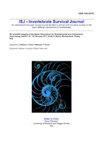饥饿和不同营养类型对印度斑间Plodia interpunctella (h bner)血细胞特征和酚氧化酶活性的影响(鳞翅目:皮蛾科)
IF 1.2
4区 农林科学
Q4 IMMUNOLOGY
引用次数: 1
摘要
昆虫的防御机制是基于血细胞和酚氧化酶的参与。血细胞是细胞免疫的基本组成部分,而酚氧化酶作为酚氧化酶原级联的一部分,是体液和细胞防御的组成部分。营养、饥饿和任何生物体的攻击都可以改变先天免疫的这些参数。本研究探讨了饥饿或不同类型的日粮胁迫对印度粉蛾幼虫重要免疫方面的影响。结果显示,随着饥饿时间的延长,血淋巴中总血细胞计数下降。第1组分别饲喂24、48、72 h的5龄幼虫,观察其血细胞数量和酚氧化酶活性的变化。试验2采用日粮(A)核桃、日粮(B)开心果、日粮(C)豌豆和葡萄干、日粮(D)人工饲料4种饲料饲养。还考虑了血细胞总数和每个血细胞的百分比。幼虫在恒温箱中培养,温度为25±1℃,相对湿度(RH)为45%,恒定光周期为14:10 h (L:D)。作为主要免疫细胞之一的浆细胞数量随着饥饿时间的延长而急剧减少,最终达到134.04±25.25 mm3(血淋巴)。与其他处理相比,饥饿后72 h的粒细胞数量也显著减少。作为干细胞的原血细胞在24 h内开始增多,随后减少。作为参与酚氧化酶活性的关键细胞的卵泡细胞在饥饿24 h内开始较对照显著增加,但在饥饿48和72 h达到与对照相同的水平后,卵泡细胞数量显著下降。结果表明,饲料种类影响细胞数量和酚氧化酶活性。总血细胞计数以以豌豆和葡萄干为食的最高(2158.18±172.5 mm3),以开心果为食的最低(924±78.33 mm3)。饲粮(C)豌豆、葡萄干和饲粮(D)人工饲粮中,浆细胞、粒细胞和卵泡细胞数量最高,其他处理最低。不同饵料的幼虫中原血细胞数量差异不显著。饥饿后5龄幼虫酚氧化酶活性显著降低。各饲养处理中,人工饲料的酚氧化酶活性最高,开心果饲料的酚氧化酶活性最低。因此,饮食的数量和类型以及包括饥饿在内的应激可以决定昆虫对昆虫病原体的免疫反应。本文章由计算机程序翻译,如有差异,请以英文原文为准。
Investigating the effect of starvation and various nutritional types on the hemocytic profile and phenoloxidase activity in the Indian meal moth Plodia interpunctella (Hübner) (Lepidoptera: Pyralidae)
The defense mechanisms of the insects are based on involvement of the hemocytes and phenoloxidase. Hemocytes are the basic component of the cellular immunity and phenoloxidase as the part of prophenoloxidase (PPO) cascade is the component of both humoral and cellular defense. Nutrition as well as starvation and attack by any organisms can modify these parameters of the innate immunity. In the current study, the effects of the stresses imposed by the starvation or different types of diets were investigated on the important immunity aspects of the indian meal moth larvae. Results showed a decline in the total hemocyte count in hemolymph with the increase in the starvation duration. In the first test, 5th instar larvae were starved for three time intervals including 24, 48, and 72 h and then, the changes in hemocyte number and phenoloxidase activity were studied. In the second experiment, the larvae bred on four diets including diet (A) walnut, diet (B) pistachio, diet (C) pea and raisin, and diet (D) artificial diets were used. The total number of the hemocytes and percentage of each hemocyte were also considered. Larvae were kept in an incubator set at a temperature of 25 ± 1 °C with 45 % of relative humidity (RH), and a constant photoperiod of 14:10 h (L:D) during the tests. The number of the plasmatocytes, one the main immune cells was sharply decreased with prolongation of the starvation duration and finally, their number reached by 134.04 ± 25.25 mm3 of hemolymph. The number of the granulocytes was also decreased significantly 72 h post-starvation than other treatments. The prohemocytes as the stem cells were initially increased within 24 h, and they were decreased later. The oenocytoids as the key cells involved in the phenoloxidase activity were initially increased significantly within 24 h of starvation compared to the control, but they were decreased significantly after 48 and 72 h reaching the same amount as the controls. Results revealed that the types of the consumed diet influenced the number of cells and phenoloxidase activity. The highest total hemocyte count was related to the diet (C) pea and raisins (2158.18 ± 172.5 mm3), and the lowest was observed in the larvae fed on the pistachios (924 ± 78.33 mm3). The number of plasmatocytes, granulocytes, and oenocytoids was the highest in those larvae fed on the diet (C) pea and raisin and diet (D) artificial diet, respectively but the lowest numbers were observed for other treatments. The number of prohemocytes in the larvae fed on different diets did not differ significantly. The phenoloxidase activity was significantly reduced in the fifth instar larvae following starvation. The highest activity of phenoloxidase in feeding treatments was observed in those larvae fed on the artificial diet while the lowest activity was observed in the pistachio-fed larvae. Thus, the amount and type of the diet and the stresses including starvation can determine the immune response of the insects against the entomopathogens.
求助全文
通过发布文献求助,成功后即可免费获取论文全文。
去求助
来源期刊

ISJ-Invertebrate Survival Journal
IMMUNOLOGY-ZOOLOGY
CiteScore
2.10
自引率
0.00%
发文量
0
审稿时长
>12 weeks
期刊介绍:
Invertebrate Survival Journal (ISJ) is an international and open access journal devoted to prompt and innovative studies on the basic defense mechanisms in invertebrates, in particular with a view to identifying biotechnologies able to act against derived diseases and related economic damage.
Contributions will be mainly in the form of Letters to the Editor, Visions and Perspectives, Short Communications, Technical Reports, Research Reports, Review, Minireview and Reports of Meetings. Letters to the Editor can be commentaries or perspectives on invertebrate defence mechanisms or replies to the data published in ISJ.
 求助内容:
求助内容: 应助结果提醒方式:
应助结果提醒方式:


